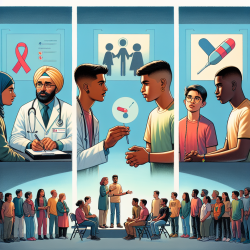Introduction
In the realm of adolescent health, HIV testing stands as a pivotal entry point for both prevention and treatment. The research article "HIV testing and linkage to services for youth" sheds light on the complexities and challenges faced by young people worldwide in accessing HIV testing services. As a practitioner, enhancing your skills in this area is crucial to effectively support the youth in your care.
Understanding the Barriers
The research highlights several barriers that hinder young people from accessing HIV testing:
- Stigma and Discrimination: Many young people, especially those from key populations (KPs) such as MSM, transgender individuals, and sex workers, face stigma and discrimination, which deters them from seeking testing.
- Developmental Challenges: Adolescents often experience a sense of invulnerability, making them less likely to seek testing despite the risks.
- Legal and Policy Constraints: Legal requirements for parental consent and lack of youth-friendly services further complicate access to testing.
Implementing Research Outcomes
To improve your practice and better support youth in accessing HIV testing, consider the following strategies:
- Create Youth-Friendly Environments: Ensure that your practice is welcoming and non-judgmental, providing a safe space for young people to discuss their health concerns.
- Enhance Health Literacy: Educate young people about the importance of HIV testing and the services available to them. Use social media and other platforms to reach a wider audience.
- Advocate for Policy Changes: Work with policymakers to reduce legal barriers, such as the requirement for parental consent, and promote policies that support youth autonomy in health decisions.
- Utilize Technology: Leverage technology, such as text messaging and online platforms, to remind and encourage young people to get tested and adhere to treatment plans.
Encouraging Further Research
While the research provides valuable insights, there is always room for further exploration. Encourage your colleagues and peers to delve deeper into:
- Innovative Testing Methods: Investigate the effectiveness of self-testing kits and other novel approaches that could increase testing rates among youth.
- Longitudinal Studies: Conduct studies that track the long-term outcomes of youth who access HIV testing and treatment services.
- Interdisciplinary Approaches: Collaborate with professionals from various fields to develop comprehensive strategies that address the multifaceted challenges faced by youth.
Conclusion
By implementing the outcomes of this research and continuing to explore new avenues, practitioners can play a crucial role in improving access to HIV testing and care for young people. Together, we can work towards a future where all youth have the knowledge and resources they need to protect their health.
To read the original research paper, please follow this link: HIV testing and linkage to services for youth.










